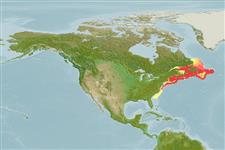Environment: milieu / climate zone / depth range / distribution range
بوم شناسي
دريايي نزديك كف زي; اقیانوس رو (Ref. 51243); تغييرات عمق 55 - 914 m (Ref. 58452). Temperate; 55°N - 24°N, 80°W - 42°W (Ref. 54581)
Northwest Atlantic: coast of Canada and USA from Bell Isle Channel to the Bahamas; most common from southern Newfoundland to South Carolina.
Length at first maturity / Size / Weight / سن
Maturity: Lm 23.2 range ? - ? cm
Max length : 76.0 cm TL جنس نر / بدون خواص جنسي; (Ref. 1371); common length : 37.0 cm TL جنس نر / بدون خواص جنسي; (Ref. 1371); common length :65 cm TL (female); بيشينه وزن گزارش شده: 2.3 kg (Ref. 1371); بيشينه سن گزارش شده: 12 سال ها (Ref. 1371)
خارهاي باله پشتي (کل) : 1; شعاع نرم باله پشتي (کل) : 47 - 54; خارهاي باله مخرجي: 0; شعاع نرم باله مخرجي: 37 - 41. Head large, about 30% of SL . Pectoral fins long, reaching origin of anal fin. Overall color is silvery, somewhat brownish on back, whitish on belly.
Abundant on sandy grounds and strays into shallower waters. A voracious predator with cannibalistic habits. Individuals over 40 cm TL prey on fishes such as gadoids and herring, while smaller ones feed on crustaceans, i.e. euphausiids and pandalids; food also includes gaspereau, myctophids, smelt, silversides, mackerel, sand lance, butterfish, snakeblennies, longhorn sculpins and squids (Ref. 5951). The smallest specimen feeds mostly on crustaceans (Ref. 58452). Exhibits seasonal onshore-offshore migration (Ref. 9988). Spawning takes place from June-July in the mid-Atlantic region; July-August in the Gulf of Maine and to the north of Georges Bank, and August-September on the Scotian Shelf (Ref. 58452). Marketed fresh, smoked and frozen; fresh fish are exported to European markets; eaten fried, broiled, microwaved and baked (Ref. 9988).
Spawning appears to be strongly influenced by water temperature, and annual variations occur both in the peak and the range of the spawning period, which may influence considerably the growth of juveniles.
Cohen, D.M., T. Inada, T. Iwamoto and N. Scialabba, 1990. FAO species catalogue. Vol. 10. Gadiform fishes of the world (Order Gadiformes). An annotated and illustrated catalogue of cods, hakes, grenadiers and other gadiform fishes known to date. FAO Fish. Synop. 125(10). Rome: FAO. 442 p. (Ref. 1371)
وضعيت در فهرست قرمز IUCN (Ref. 130435: Version 2024-1)
خطر برای انسان ها
Harmless
استفاده انسانی
ماهي گيري – شيلات: با ارزش تجاري بالا; ماهي ها ي سرگرم كننده: بله
ابزارها
گزارش های ويژه
بارگيری XML
منابع اينترنتي
Estimates based on models
Preferred temperature (Ref.
123201): 0.9 - 7.8, mean 4.9 °C (based on 155 cells).
Phylogenetic diversity index (Ref.
82804): PD
50 = 0.5000 [Uniqueness, from 0.5 = low to 2.0 = high].
Bayesian length-weight: a=0.00479 (0.00399 - 0.00575), b=3.11 (3.06 - 3.16), in cm total length, based on LWR estimates for this species (Ref.
93245).
Trophic level (Ref.
69278): 4.5 ±0.4 se; based on diet studies.
Generation time: 3.4 (2.7 - 4.3) years. Estimated as median ln(3)/K based on 10
growth studies.
جهندگی (Ref.
120179): متوسط, كمينه زمان لازم براي دو برابر شدن جمعيت 4/1 – 4/4 سال (K=0.18-0.4;tm=2-3; tmax=12).
Prior r = 0.26, 95% CL = 0.17 - 0.39, Based on 3 full stock assessments.
Fishing Vulnerability (Ref.
59153): Moderate to high vulnerability (54 of 100).
Climate Vulnerability (Ref.
125649): Moderate to high vulnerability (47 of 100).
Nutrients (Ref.
124155): Calcium = 12.4 [6.5, 37.8] mg/100g; Iron = 0.245 [0.086, 0.595] mg/100g; Protein = 17.7 [16.6, 18.7] %; Omega3 = 0.276 [0.189, 0.400] g/100g; Selenium = 28.2 [14.6, 52.4] μg/100g; VitaminA = 17.2 [4.9, 58.6] μg/100g; Zinc = 0.279 [0.197, 0.387] mg/100g (wet weight);
